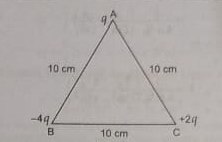EXAMPLE from MODERN PUBLICATION Chapter 9 ELECTRIC POTENTIAL for Class 12
| Class 12 | PHYSICS |
| Chapter | ELECTRIC POTENTIAL |
| MODERN PUBLICATION | EXAMPLE |
| Medium | English |
| Academic Year | 2023-2024 |
Question 20
An electron is circulating around the nucleus of a hydrogen ato in a circular orbit of radius 5.3c×10−11m. Calculate the electric potential energy of the atom in eV. What would be the electric potential due to a helium nucleus at the same radius. Given, that (4πε0)−1=9×109mF−1ande=1.6×10−19C.View SolutionQuestion 21
A molecule of a substance has a permanent electric dipole moment of magnitude 10−29 C m. A mole of this substance is polarized at low temperature by appling a strong elecrostatic field of magnitude 106Vm−1. The direction of the field is suddenly changed by an angle of 60∘. Estimate the heat released by the substance in aligning its dipole along the new direction of the field. For simplicity, assume 100% polarisation of sample.View SolutionQuestion 26
An electric dipole consists of two opposite charges of magnitude 1 μC (micro-coulomb) separated by a distance of 2 cm . The dipole is placed in an electric field of 105Vm−1.How much work must an external agent do to turn the dipole end for end , starting from a position of alignment θ=0 ?View SolutionQuestion 29
Three charges of +0.1 C each are placed at the vertices of an equilateral triangle of each side 1m. If the energy is supplied at the rate of 1.0 kw, how many hours would be required to move one of the charges on to the mid point of the line joining the other two?
Given =14πε0=9×109N2C−2View SolutionQuestion 30
Three point charges q, 2q and 8q are to be placed on a
. 9cm long straight line. Find the
. positions where the charges shouldbe placed such that the potential energy
. of this sysrem is minimum. In this situation, what is the
. electric field at the charge q due to the other two charges?View SolutionQuestion 31
A drop of water of mass 18×10−3 g falls away from the bottom of a charged conducting sphere of radius 20 cm, carrying with it a charge of 10−9C and leaving on the sphere a uniformly distributed charge of2.5×10−6C. What is the speed of the drop after it has fallen 30 cm? (4πε0)−1=9×109JmC−2View SolutionQuestion 33
Two fixed, equal, positive charges, each of magnitude 5xx10^-5 coul are located at points A and B separated by a distance of 6m. An equal and opposite charge moves towards them along the line COD, the perpendicular bisector of the line AB.
The moving charge, when it reaches the point C at a distance of 4m from O, has a kinetic energy of 4 joules. Calculate the distance of the farthest point D which the negative charge will reach before returning towards C.
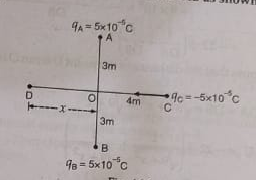 View Solution
View SolutionQuestion 34
A circular ring of radius R with uniform positive charge density λ per unit length is located in the y z plane with its center at the origin O. A particle of mass m and positive charge q is projected from that point p(−√3R,0,0) on the negative x - axis directly toward O, with initial speed V. Find the smallest (nonzero) value of the speed such that the particle does not return to P ?View SolutionQuestion 37
A conducting sphereS1of radius r is attached to an insulating handle. Another conduction sphere S2of radius R is mounted on an insulating stand. S2 is initially uncharged.S1is given a charge Q brought into contact with S2 and removed. S1 is recharge such that the charge on it is again Q and it is again brought into contact with S2and removed. This procedure is repeated n times.
Find the electrostatic energy ofS2 after n such contacts with S1. View SolutionQuestion 38
A conducting sphereS1of radius r is attached to an insulating handle. Another conduction sphere S2of radius R is mounted on an insulating stand. S2 is initially uncharged.S1is given a charge Q brought into contact with S2 and removed. S1 is recharge such that the charge on it is again Q and it is again brought into contact with S2and removed. This procedure is repeated n times.
What is the limiting value of this energy as n→∞?View SolutionQuestion 39
A non-conducting disc of radius a and uniform positive surface charge density sigma is placed on the ground, with its axis vertical. A particle of mass m and positive charge q is dropped, along the axis of the disc, from a height H with zero initial velocity. The particle has q/m=4∈0g/σ
Find the value of H if the particle just reaches the disc. View SolutionQuestion 41
What will be the corresponding expression for the energy needed to completely diassemble the planet earth against the gravitational pull amongst its constituent particles? Assume the earth to be a sphere of uniform mass density. calculate the energy, given that the product of the mass and the radius of the earth to be 2.5×1031kg−mView SolutionQuestion 71
Two charges -q and +q are located at points (0, 0, -a) and (0, 0, a), respectively. How much work is done in moving a small test charge from the point (5,0,0) to (-7,0,0) along the x-axis? Does the answer change if the path of the test charge between the same points is not along the x-axis?View SolutionQuestion 83
Two identical plane metallic surfaces A and B are parallel to each other in air separated by a distance of 1 cm as shown in the fig.
 Surface A is given a postive potential 10 V and the outer surface of B is earthend What is the magnitude and direction of the uniform electric field between points Y and Z?View Solution
Surface A is given a postive potential 10 V and the outer surface of B is earthend What is the magnitude and direction of the uniform electric field between points Y and Z?View SolutionQuestion 94
The following data was obtained for the dependence of the magnitude of electric field with distance from a reference point O, within the charge distribution in the shaded region show in the fig.
If the potential due to this charge distribution has a value V at the point A, what is its value at the point A'?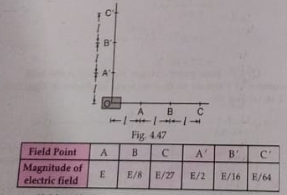 View Solution
View SolutionQuestion 115
The Millikan oil-drop experiment enabled the charge on the electron to be deterined. Two parallel metal plates P and Q are situated in a vaccum. The plates are horizontal and separated by a distance of 5.4 mm, as illustrated in fig. The lower plate P is earthed. The potential difference between the plates can be varied. An oil droplet of mass 7.7×10−15 kg is oserved to remain stationary between the plates , when palte Q is a t a potential of +850 suggest why plates p and Q must be parallel and horizontal and calcualte the charge with its gin, on the oil droplet.View Solution
The lower plate P is earthed. The potential difference between the plates can be varied. An oil droplet of mass 7.7×10−15 kg is oserved to remain stationary between the plates , when palte Q is a t a potential of +850 suggest why plates p and Q must be parallel and horizontal and calcualte the charge with its gin, on the oil droplet.View SolutionQuestion 120
Work done to move a charge along a closed path inside an electric field is always zero. Use this fact to prove that it is impossible to produce an electric field in which all the lines of force would be parallel straight lines and the density of their distribution would constantly increase in a direction perpendicular to the lines of force as shown in Figure.
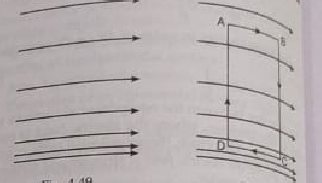 View Solution
View SolutionQuestion 127
In a particular experiment, a high vltage is created by charging an isolated metal sphereas shown in the fig.
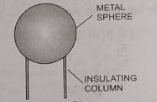 The sphere has diameter 42 cm and any charge on its surface may be considered as if IT were concentrated at its centre. The air surrounding the sphere loses its insultaing properties, causing a spark, when the electric field exceeds 20kVcm−1 by reference to an atom in the air, suggest the mechanism by which the electric field causes the air to become conducting.View Solution
The sphere has diameter 42 cm and any charge on its surface may be considered as if IT were concentrated at its centre. The air surrounding the sphere loses its insultaing properties, causing a spark, when the electric field exceeds 20kVcm−1 by reference to an atom in the air, suggest the mechanism by which the electric field causes the air to become conducting.View SolutionQuestion 128
In a particular experiment, a high voltage is created by charging an isolated metal sphere as shown in the fig.
The sphere has diameter 42 cm and any charge on its surface may be considered as if it were concentrated at its center. The air surrounding the sphere loses its insulating properties, causing a spark, when the electric field exceeds 20kVcm−1 . Calculate for the charged sphere when a spark is about to occur the charge on the sphere and its potential.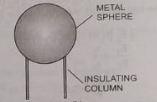 View Solution
View SolutionQuestion 129
Two small charged metal sphere A and B are situated in a vaccum. The distance between the centres of the spheres is 12.0 cm, as shown in the fig.
The charge on each sphere may be assumed to be a point charge at the centre of the sphere. Point P is a movable point that lies on the line joining the centres of the sphere and is distance x fromt he centre of sphere A. The variation with distance x fo the electric field strength E at point P as shown in the figure.
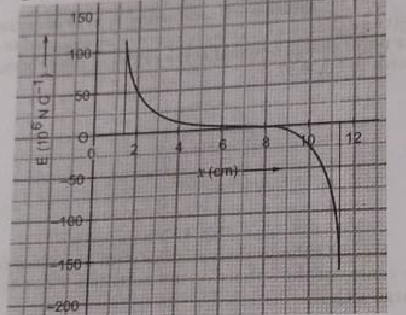
State the evidence provided by in the fig for the statement that the spheres are conductors, the charges on the spheres are either both positive or both negative.View SolutionQuestion 130
Two small charged metal sphere A and B are situated in a vaccum. The distance between the centres of the spheres is 12.0 cm, as shown in the fig.
The charge on each sphere may be assumed to be a point charge at the centre of the sphere. Point P is a movable point that lies on the line joining the centres of the sphere and is distance x fromt he centre of sphere A. The variation with distance x fo the electric field strength E at point P as shown in the figure.
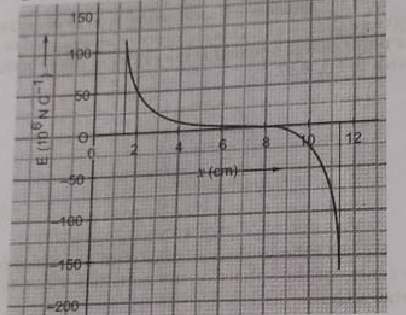
Use fig to state and explain the distance x at which the rate of change of potential with distance is maximum and minimum.View SolutionQuestion 168
An electric dipole consists of two opposite charges each of magnitude 6×10−8 coulomb separated by 6.0cm. The dipole is placed in an external electric field of 5×10−5NC−1 How much work will an external agent have to do in turning the dipole through 180∘, starting from the position θ=0∘?View Solution

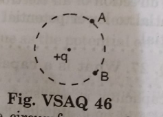
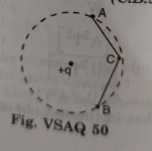
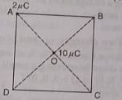
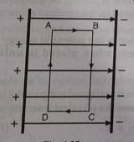
 is the potential difference
is the potential difference 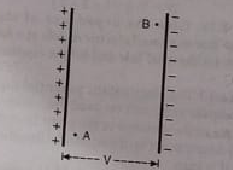
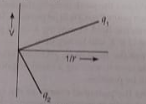 What are the signs of the two charges?
What are the signs of the two charges?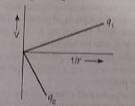 Which of the two charges has a larger magnitude and why?
Which of the two charges has a larger magnitude and why?
 At which point( of the two) is the electric potential more and why?
At which point( of the two) is the electric potential more and why? Will the electric field at the centre of the square, be the same or different in the two configurations and why?
Will the electric field at the centre of the square, be the same or different in the two configurations and why?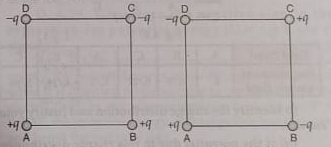 electric potential at the centre of the square be the same or difference in the two configurations and why?
electric potential at the centre of the square be the same or difference in the two configurations and why?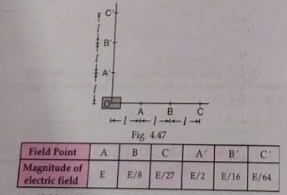 Identify the charge distribution and justify your answer.
Identify the charge distribution and justify your answer. 
 It is known that
It is known that 